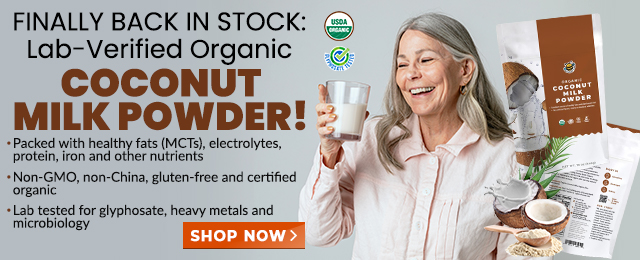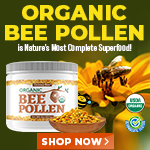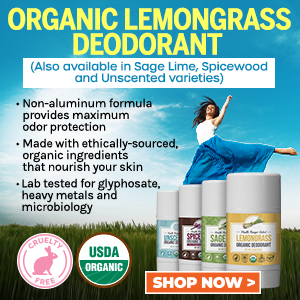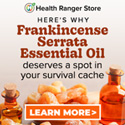
Fabric softeners contain toxic chemicals
Wednesday, January 11, 2012 by: Selena Keegan
Tags: fabric softeners, toxic chemicals, laundry
- Warp Speed 2.0: Trump Administration ACCELERATES Gates-funded, self-amplifying bird flu vaccines
- DMSO and Natural Dyes: A suppressed cancer treatment resurfaces in independent research
- Transhuman vectors of disease: Young adults continue to produce spike proteins ONE YEAR after receiving COVID vaccine
- Aerosolized bioweapons? Strange “diploid biomasses” falling out of the sky in Florida captured under the microscope
- Study finds bananas more effective than salt reduction for lowering blood pressure
- Chemical cocktails in processed foods linked to diabetes, validating natural health warnings
- STAGING BEFORE RELEASE: WHO Runs 2-Day Pandemic Simulation 'Exercise Polaris'
- 8 U.S. states may EXPAND vaccine exemptions in 2025, and parents have many reasons to STOP THE SHOTS
- Prominent doctors call for new holistic therapies to address CANCER SPIKE: Tree barks provide anti-cancer treatment options
- Fermented foods like sauerkraut may outshine modern medicine in gut health, research finds
- Ancient mummies rewrite human history with “ghost” lineage discovery
- Widespread social and economic unrest: Steve Quayle issues urgent financial warning of imminent asset collapse in new interview with Mike Adams
- Analysis: The coming economic collapse, a mass uprising and Trump's three secret weapons to halt the growing revolt
- Surge in KIDNEY FAILURES linked to common medications
- Mike Adams releases country western hit single: Goin’ Back in Time is Comin’ Home
- Fauci is back in the limelight, and he’s busy promoting a future COVID or FLU pandemic
- Kiss Your Genetic Privacy Good-Bye! 23andMe Gets Green Light to Sell Your Intimate Genetic Details to Anyone They Want
- U.S. lawmakers investigate Meta over alleged China collaboration
- Israeli lobbyists boast of controlling US national security policy in leaked AIPAC audio
- Aerosolized bioweapons? Strange “diploid biomasses” falling out of the sky in Florida captured under the microscope
- Analysis: The coming economic collapse, a mass uprising and Trump's three secret weapons to halt the growing revolt
- Fauci is back in the limelight, and he’s busy promoting a future COVID or FLU pandemic
- Widespread social and economic unrest: Steve Quayle issues urgent financial warning of imminent asset collapse in new interview with Mike Adams
- Kiss Your Genetic Privacy Good-Bye! 23andMe Gets Green Light to Sell Your Intimate Genetic Details to Anyone They Want
- Mike Adams releases country western hit single: Goin’ Back in Time is Comin’ Home
- U.S. lawmakers investigate Meta over alleged China collaboration
- Tulsi Gabbard leads charge against the Biden regime’s global censorship of the 'Disinformation Dozen'
- Pfizer's RSV vaccine linked to preterm births as drug giant CONCEALED RISKS from pregnant women in unethical clinical trials
- Dane Wigington exposes climate engineering as ‘All-Out Weather and Biological Warfare’
- Shedding light on the dark side of MMR vaccines: How vaccinated individuals SPREAD MEASLES & put the vulnerable at risk
- TAKE IT DOWN Act advances in Congress amid free speech concerns
- CLOT SHOT PLANDEMIC UNFOLDING: Fibrous, rubbery clots caused by covid injections have prion-like seeding activity
- Chemtrails unveiled: How the CIA and Big Business are manipulating the weather for profit
- Curcumin’s ancient healing power supercharges muscle recovery, and its effects are compounded with anti-inflammatory foods and supplements
- Criminal referral requests filed against Fauci and top COVID officials in seven states
- Defunding DEADLY mRNA jabs: Government funding for mRNA technology being scrutinized and sidelined until proven "safe and effective" for real
- Newly released JFK files reveal Pentagon's role in creating Lyme disease and covid in the same lab
- Analysis: The coming economic collapse, a mass uprising and Trump's three secret weapons to halt the growing revolt
- Mike Adams releases country western hit single: Goin’ Back in Time is Comin’ Home
- Aerosolized bioweapons? Strange “diploid biomasses” falling out of the sky in Florida captured under the microscope
- Kiss Your Genetic Privacy Good-Bye! 23andMe Gets Green Light to Sell Your Intimate Genetic Details to Anyone They Want
- European Court of Justice: Healthcare professionals who promoted or administered COVID-19 vaccines are CRIMINALLY LIABLE for any harm caused
- Federal employees whine over DOGE's new directive requiring them to do a 5-point summary of weekly accomplishments
- Widespread social and economic unrest: Steve Quayle issues urgent financial warning of imminent asset collapse in new interview with Mike Adams
- U.S. approves new Russian ambassador as diplomatic thaw continues
- Government waste exposed: Hegseth supports Musk’s demand for accountability from federal workers
- Now you can HEAR chemistry: Health Ranger translates molecules into music in stunning video demonstration that will blow your mind (and your ears)
- Fauci is back in the limelight, and he’s busy promoting a future COVID or FLU pandemic
- CLOT SHOT PLANDEMIC UNFOLDING: Fibrous, rubbery clots caused by covid injections have prion-like seeding activity
- I Want My Bailout Money – new song released by Mike Adams
- I Want My Bailout Money – new song and music video released by Mike Adams
- Tulsi Gabbard leads charge against the Biden regime’s global censorship of the 'Disinformation Dozen'
- Trump administration poised to overhaul crypto regulations with new SEC leadership
- The Health Ranger releases “Vaccine Zombie” song and music video, using AI-animated zombies for the music video
- Red Cross issues warning to stop blood plasma donations from vaccinated people
- Scientists confirm: GENIUS brain function can be spontaneously unleashed in humans without any apparent cause
- EPA advisor admits the agency is funneling billions to climate groups ahead of Trump’s return to White House
- HYSSOP: What research reveals about the health benefits of this ancient holy herb
- Two containers with completed ballots fall out of truck in Florida
- Newly released JFK files reveal Pentagon's role in creating Lyme disease and covid in the same lab
- Global leaders unite to clamp down on “misinformation” with UN-backed Cascais Declaration
- Mike Adams releases country western hit single: Goin’ Back in Time is Comin’ Home
- BREAKING: 2025 NDAA authorizes mandatory military draft of WOMEN across America… as Pentagon pursues global NUCLEAR war with both Russia and China at the same time
- Michael Yon warns of a ZIONIST TAKEOVER in Trump’s second administration
- The Health Ranger releases “Vaccine Zombie” song and music video, using AI-animated zombies for the music video
- Ozempic and Wegovy weight loss drugs are injectable LIZARD VENOM PEPTIDES that may unleash a devastating wave of organ failure… side effects align with symptoms of SNAKE BITES
- BOMBSHELL: DNA testing kits are a SCAM to develop ethnic-specific bioweapons
- Israeli soldiers accused of even more torture and abuse in the West Bank
- I Want My Bailout Money – new song released by Mike Adams
- These 13 countries just signed an agreement to engineer a global FAMINE by destroying food supply
- NASA admits that climate change occurs because of changes in Earth’s solar orbit, and NOT because of SUVs and fossil fuels
- RFK Jr. clears key hurdle: Sen. Susan Collins backs controversial HHS nominee, signaling a new era for health policy
Some of the harmful ingredients commonly found in liquid or sheet fabric softeners include:
• Chloroform: This substance was used as an anesthesia in the 1800s up through the early 1900s when its potential for causing fatal cardiac arrhythmia was discovered. A carcinogenic neurotoxin, it is on the EPA's Hazardous Waste list. Inhaling its vapors may cause loss of consciousness, nausea, headache, vomiting, and/or dizziness, drowsiness. It may aggravate disorders of the heart, kidneys or liver. Its effects worsen when subjected to heat.
• A-Terpineol: Causes Central Nervous System (CNS) disorders, meaning problems relating to the brain and spine such as Alzheimer's disease, ADD, dementia, Multiple Sclerosis, Parkinson's disease, seizures, strokes, and Sudden Infant Death Syndrome. Early symptoms of CNS problems include aphasia, blurred vision, disorientation, dizziness, headaches, hunger, memory loss, numbness in face, pain in neck and spine. A-Terpineol also irritates the mucous membranes and, if aspirated into the lungs, can cause respiratory depression, pneumonia or fatal edema.
• Benzyl Alcohol: This upper respiratory tract irritant can cause central nervous system (CNS) disorders, headache, nausea, vomiting, dizziness and dramatic drops in blood pressure.
• Benzyl Acetate: This substances has been linked to pancreatic cancer. Its vapors can be irritating to eyes and respiratory passages and it can also be absorbed through the skin.
• Ethanol: Another fabric softener ingredient which is on the EPA's Hazardous Waste list and linked to CNS disorders.
• Pentane: A chemical known to be harmful if inhaled.
• Ethyl Acetate: This substance, which is on the EPA's Hazardous Waste list, can be irritating to the eyes and respiratory tract. It may also cause severe headaches and loss of consciousness, as well as damage to the liver and kidneys.
• Camphor: Another substance on the EPA's Hazardous Waste list. It is easily absorbed through body tissue, causing irritation of eyes, nose and throat. Camphor can also cause dizziness, confusion, nausea, twitching muscles and convulsions.
• Linalool: A narcotic known to cause respiratory problems and CNS disorders. In animal testing, exposure to linalool has resulted in death.
• Phthalates: Used in scented products to help the scent last longer, phthlates have been linked to breast cancer and reproductive system problems.
• Limonene: This known carcinogen can cause irritation to eyes and skin.
• Also, if you follow a vegan lifestyle, you should be aware that many fabric softener sheets are made using tallow, a form of animal fat.
Manufacturers are aware that the products contain toxic chemicals. The packaging on many brands include a warning that the product should not be used on children's sleepwear. Since some of the same brands also have large images of children and toys, however, consumers may miss the small print message.
Breathing and wearing poison
If you use fabric softener, these toxic chemicals coat your towels, sheets and clothing so that you absorb toxins through your skin, the largest organ of the body. When you wear chemically "softened" clothes, you inhale these chemicals with every breath. Even if you do not use fabric softener, you can ingest these chemicals through dryer exhaust sending them into the air or simply by working with someone whose clothes have been chemically treated in this way. Fabric softeners are designed to remain in fabric for a long period of time, slowly releasing into the air.Fabric softeners were invented to hide the unpleasant smells of synthetic fabrics, whose odors tend to become stronger when heated, whether on a sweating, active body or in the dryer. The chemicals in fabric softeners include those meant to eliminate static cling, as well as perfumes to disguise both the other chemicals and the odor of synthetic fabrics.
Alternatives
Fabrics air dried outside on a line do not develop static cling and are more likely to have a natural pleasant smell. If weather or other factors make natural line drying of your clothes an impractical choice, try using more other natural means to eliminate static cling and impart a fresh smell to your laundry.If possible, install a water softener. You can also eliminate many clothing odors by thoroughly dissolving a cup of baking soda in the water before putting your clothes in the washing machine.
There are several types of dryer ball products on the market. The ones made of rubber may not be the most eco-conscious means of reducing static as these may off-gas. Instead, try the variety made of felted wool. Some natural retailers offer dryer bags, like large tea bags, containing dried lavender. You can also make your own version of these bags by sewing laundry sachets using cotton muslin and filling them with your favorite dried herbs.
In part two of this series, we will look at the listed ingredients and warnings for mainstream fabric softeners, as well as some product lines which are both vegan and environmentally friendly.
Sources:
http://www.epa.gov/dfe/pubs/laundry/consider/
http://planetgreen.discovery.com/fashion-beauty/replace-fabric-softener-vinegar.html
http://www.naturallifemagazine.com/0608/softener.htm
http://shop.sixwise.com/thetoxicdangeroffabricsofteneranddryersheets2805.aspx
http://users.lmi.net/wilworks/ehnfs.htm
http://www.environmentalhealth.ca/special/fall07FabricSofteners.html
http://www.norwexgreenclean.net/page/page/5367159.htm
http://www.care2.com/greenliving/6-natural-alternatives-to-toxic-fabric-softeners.html
Fabric softeners at FETCH.news
Get independent news alerts on natural cures, food lab tests, cannabis medicine, science, robotics, drones, privacy and more.
Take Action: Support Natural News by linking to this article from your website
Permalink to this article:
Embed article link: (copy HTML code below):
Reprinting this article:
Non-commercial use OK, cite NaturalNews.com with clickable link.
Follow Natural News on Facebook, Twitter, Google Plus, and Pinterest
Science News & Studies
Medicine News and Information
Food News & Studies
Health News & Studies
Herbs News & Information
Pollution News & Studies
Cancer News & Studies
Climate News & Studies
Survival News & Information
Gear News & Information
News covering technology, stocks, hackers, and more



"Big Tech and mainstream media are constantly trying to silence the independent voices that dare to bring you the truth about toxic food ingredients, dangerous medications and the failed, fraudulent science of the profit-driven medical establishment.
Email is one of the best ways to make sure you stay informed, without the censorship of the tech giants (Google, Apple, Facebook, Twitter, YouTube, etc.). Stay informed and you'll even likely learn information that may help save your own life."
–The Health Ranger, Mike Adams













































